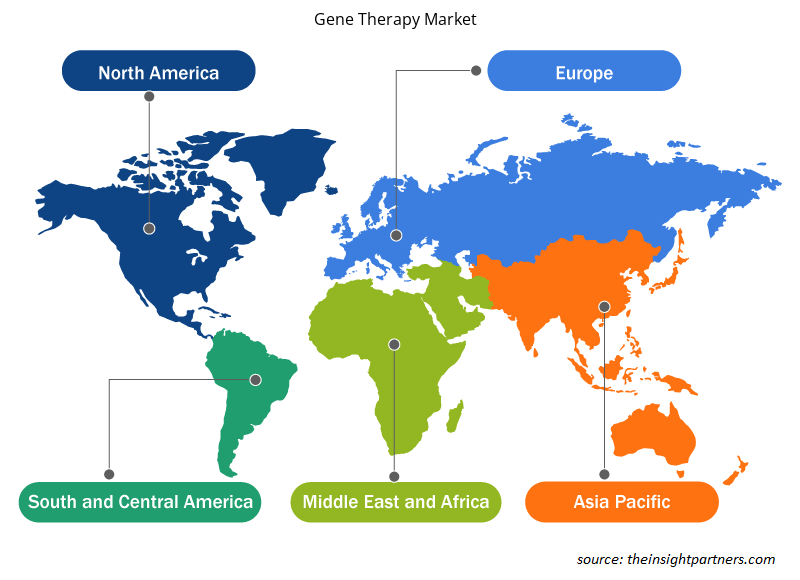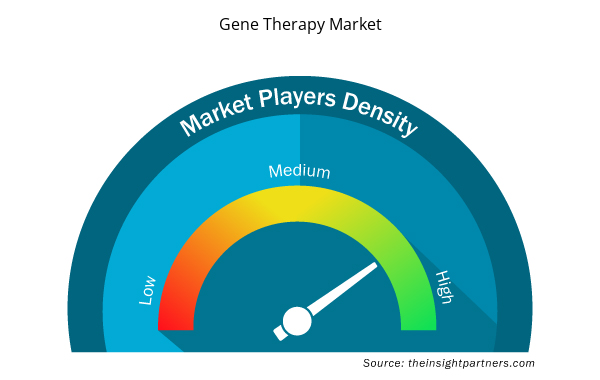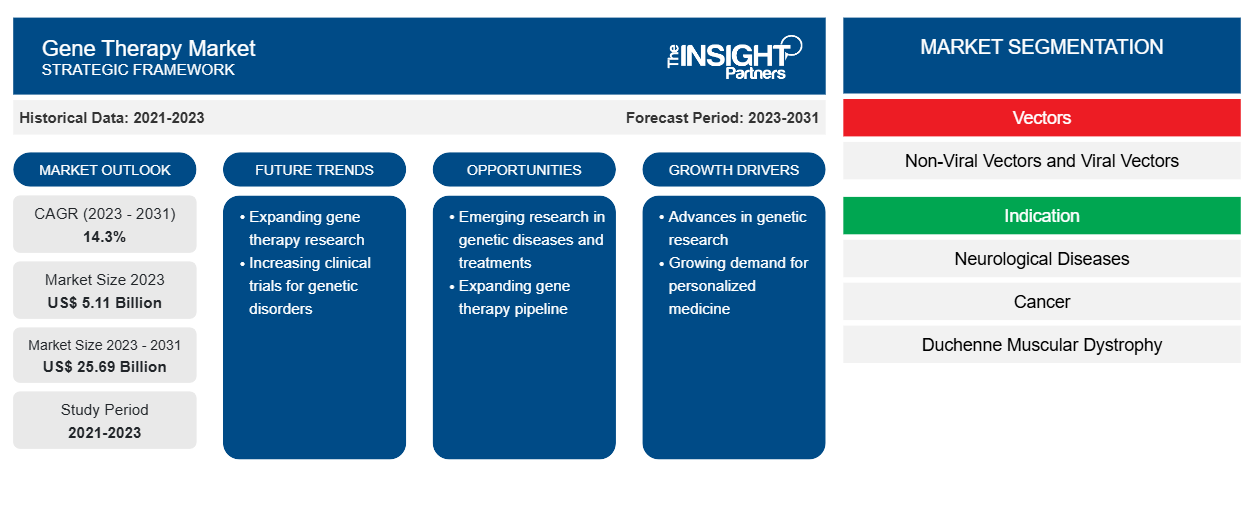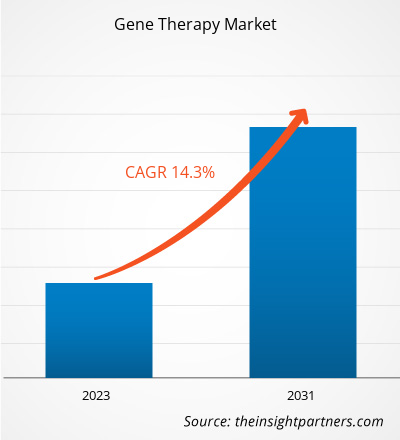[研究报告] 基因治疗市场规模预计将从 2023 年的 51.1 亿美元增至 2031 年的 256.9 亿美元;预计 2023-2031 年期间的复合年增长率为 14.3%。
市场洞察和分析师观点:
基因治疗是一种治疗疾病的过程,通过灭活致病基因、用健康的基因副本替换致病基因或将新的或经过修改的基因引入体内来帮助治疗和预防疾病。基因治疗可分为体内和体外基因治疗。基因治疗的目的是用正常的基因替换或纠正有缺陷的基因,使身体产生正常功能所需的正确蛋白质或酶,从而有可能治愈疾病的根本原因。全球遗传病和癌症的患病率不断上升,FDA 批准的基因疗法数量不断增加,这有利于基因治疗市场的增长。此外,基因治疗市场的趋势包括基因治疗技术的进步,这将有利于未来市场的增长。
增长动力:
生物技术的进步 促进了多种疾病治疗方法的发展。基因疗法被用于治疗各种疾病,例如癌症、神经系统疾病和遗传疾病。由于美国食品药品管理局 (FDA) 批准的产品随处可见,基因疗法在全球范围内被广泛采用。以下是近年来 FDA 批准的一些基因治疗产品的例子:
- 2023 年 12 月,FDA 批准了两种用于治疗镰状细胞病的细胞基因疗法。Bluebird Bio 的 Lyfgenia (lovotibeglogene autotemcel) 获批用于治疗有血管闭塞事件病史的 12 岁及以上镰状细胞病患者。它与 Vertex Pharmaceuticals 和 CRISPR Therapeutics 的 Casgevy (exagamglogene autotemcel) 一起获得批准。
- 2023 年 6 月,FDA 批准了 Roctavian,这是一种基于腺相关病毒载体的基因疗法,用于治疗没有腺相关病毒血清型 5 抗体的重度血友病 A 成人患者。遗传性血友病 A 是一种严重的出血性疾病,由基因突变引起,该基因突变负责产生凝血因子 VIII (FVIII),这是一种能够凝血的蛋白质。Roctavian 是一种一次性基因治疗产品,含有携带凝血因子 VIII 基因的病毒载体。
- 2023 年 6 月,FDA 批准了 Elevidys,这是首个用于治疗杜氏肌营养不良症的基因疗法,适用于已确诊患有杜氏肌营养不良症基因突变且没有阻碍该疗法治疗的既往疾病的 4 至 5 岁儿科患者。
- 2022 年 11 月,FDA 批准了由 CSL Behring LLC 生产的 HEMGENIX,这是一种重组腺相关病毒 5 型基因疗法,用于治疗患有某些类型的血友病 B 的成年患者。
因此,这些基因疗法的认可度不断提高,推动了基因治疗市场的增长。
定制此报告以满足您的需求
您可以免费定制任何报告,包括本报告的部分内容、国家级分析、Excel 数据包,以及为初创企业和大学提供优惠和折扣
- 获取此报告的关键市场趋势。这个免费样品将包括数据分析,从市场趋势到估计和预测。
报告细分和范围:
基因治疗市场分析考虑了以下几个部分:载体、适应症、给药方式和地理位置。根据载体,市场分为非病毒载体和病毒载体。根据适应症,市场分为神经系统疾病、癌症、杜氏肌营养不良症、肝病和其他适应症。根据给药方式,市场分为体内和体外。基因治疗市场报告的范围涵盖北美(美国、加拿大和墨西哥)、欧洲(法国、德国、英国、西班牙、意大利和欧洲其他地区)、亚太地区(中国、日本、印度、澳大利亚、韩国和亚太地区其他地区)、中东和非洲(沙特阿拉伯、南非、阿联酋和中东和非洲其他地区)以及南美洲和中美洲(巴西、阿根廷和南美洲和中美洲其他地区)。
节段分析:
基因治疗市场按载体可分为非病毒载体和病毒载体。病毒载体部分在 2023 年占据了相当大的市场份额。预计 2023-2030 年期间市场复合年增长率将更高。
根据适应症,市场分为神经系统疾病、癌症、杜氏肌营养不良症、肝病和其他适应症。癌症领域在 2023 年占据了基因治疗市场的很大份额,预计在 2023-2030 年期间将实现最高的复合年增长率。
根据递送方式,市场分为体内和体外。体内部分在 2023 年占据了基因治疗市场的很大份额,预计在 2023-2030 年期间将实现更高的复合年增长率。体内基因治疗可实现系统性治疗,这意味着它可以到达全身的多个部位和器官。这对于影响多个区域或具有系统性症状的疾病尤其有用,可实现全面的治疗方法。此外,病毒载体、纳米颗粒和脂质载体等先进递送技术的开发提高了体内治疗的有效性和特异性。这些进步促进了遗传物质的靶向递送,并提高了治疗的安全性和有效性。
区域分析:
从地理上看,基因治疗市场分为北美、欧洲、亚太地区、南美和中美以及中东和非洲。2023 年,北美占据了相当大的市场份额。2023 年,美国主导了该地区的基因治疗市场。北美市场的增长归因于遗传疾病的患病率不断上升、癌症患者人数不断增加、政府资金不断增加、先进基因疗法在疾病治疗中的采用率不断提高以及产品批准率不断提高。
根据美国疾病控制与预防中心 (CDC) 的数据,2020 年美国新增癌症病例约 1,603,844 例,癌症死亡人数约 602,347 人。每 100,000 人中,有 403 例新增癌症病例。此外,根据国际癌症研究机构的数据,到 2040 年,新增癌症病例预计将达到 3020 万。根据美国政府问责局 2021 年 10 月发布的估计,美国约有 2500 万至 3000 万人口患有罕见病;近 50% 的罕见病患者是儿童。罕见病通常是基因突变的结果;据估计,80% 的罕见病是遗传性的。
根据美国国立卫生研究院 2021 年 10 月的最新消息,10 家制药公司和 5 家非营利组织已合作加速开发基因疗法,以造福 3000 万患有罕见疾病的美国人。美国 FDA 已批准 7 种细胞和基因治疗药物,新产品管线已达到约 1,200 种实验性疗法。根据《化学与工程新闻》2023 年报告估计,其中一半处于第 2 阶段临床试验阶段,细胞疗法的年销售额增长率估计为 15%,基因疗法的年销售额增长率估计为约 30%。上述所有因素都促进了该地区基因治疗市场规模的不断增长。
基因治疗市场区域洞察
Insight Partners 的分析师已详细解释了预测期内影响基因治疗市场的区域趋势和因素。本节还讨论了北美、欧洲、亚太地区、中东和非洲以及南美和中美洲的基因治疗市场细分和地理位置。

- 获取基因治疗市场的区域特定数据
基因治疗市场报告范围
| 报告属性 | 细节 |
|---|---|
| 2023 年的市场规模 | 51.1亿美元 |
| 2031 年市场规模 | 256.9 亿美元 |
| 全球复合年增长率(2023 - 2031) | 14.3% |
| 史料 | 2021-2023 |
| 预测期 | 2023-2031 |
| 涵盖的领域 | 通过矢量
|
| 覆盖地区和国家 | 北美
|
| 市场领导者和主要公司简介 |
|
基因治疗市场参与者密度:了解其对业务动态的影响
基因治疗市场正在快速增长,这得益于终端用户需求的不断增长,而这些需求又源于消费者偏好的不断变化、技术进步以及对产品优势的认识不断提高等因素。随着需求的增加,企业正在扩大其产品范围,进行创新以满足消费者的需求,并利用新兴趋势,从而进一步推动市场增长。
市场参与者密度是指在特定市场或行业内运营的企业或公司的分布情况。它表明在给定市场空间中,相对于其规模或总市场价值,有多少竞争对手(市场参与者)存在。
在基因治疗市场运营的主要公司有:
- 诺华公司
- 安斯泰来制药公司
- 百时美施贵宝公司
- 蓝鸟生物公司
- 赛诺菲
免责声明:上面列出的公司没有按照任何特定顺序排列。

- 了解基因治疗市场的主要参与者概况
行业发展和未来机遇:
- 2022 年 1 月,Ori Biotech Ltd 在超额认购的 B 轮融资中获得超过 1 亿美元,用于向市场推出创新的细胞和基因治疗制造平台。
- 2020年1月,安斯泰来制药公司收购了Audentes Therapeutics公司,此次收购使合并后的公司成为基于AAV的基因医学领域的全球领导者。
竞争格局和重点公司:
基因治疗市场预测可以帮助利益相关者规划其增长战略。诺华公司、安斯泰来制药公司、百时美施贵宝公司、蓝鸟生物公司、杰特罗贝林公司、赛诺菲公司、罗氏公司、第一三共、百健和牛津生物医药公司是基因治疗市场报告中介绍的知名企业。这些公司专注于推出新的高科技产品、改进现有产品和扩大地域范围,以满足全球日益增长的消费者需求。
- 历史分析(2 年)、基准年、预测(7 年)及复合年增长率
- PEST 和 SWOT 分析
- 市场规模价值/数量 - 全球、区域、国家
- 行业和竞争格局
- Excel 数据集



Report Coverage
Revenue forecast, Company Analysis, Industry landscape, Growth factors, and Trends

Segment Covered
This text is related
to segments covered.

Regional Scope
North America, Europe, Asia Pacific, Middle East & Africa, South & Central America

Country Scope
This text is related
to country scope.
常见问题
The gene therapy market majorly consists of the players, including Novartis AG, Astellas Pharma Inc., Bristol-Myers Squibb Company, Bluebird Bio Inc., CSL Behring, Sanofi, F. Hoffmann-La Roche Ltd, Daiichi Sankyo, Biogen, and Oxford Biomedica.
The gene therapy market was valued at US$ 5.11 billion in 2023.
The factors driving the growth of the gene therapy market include the increasing burden of genetic diseases and the rising number of FDA approvals of gene therapies. However, the high cost of gene therapy products hampers the growth of the gene therapy market.
The gene therapy market is expected to be valued at US$ 25.69 billion in 2031.
The global gene therapy market is segmented based on vectors, indication, and delivery mode. Based on indication, the gene therapy market is categorized into neurological diseases, cancer, Duchenne muscular dystrophy, hepatological diseases, and other indications. The cancer segment held a significant market share in 2023 and is anticipated to record the highest CAGR in the market during 2023–2031.
Gene therapy is a process for the treatment of diseases by inactivating a disease-causing gene, replacing a disease-causing gene with a healthy copy of the gene, or introducing a new or modified gene into the body to help treat and prevent the disease.
Trends and growth analysis reports related to Life Sciences : READ MORE..
The List of Companies - Gene Therapy Market
- Novartis AG
- Astellas Pharma Inc.
- Bristol-Myers Squibb Company
- Bluebird Bio Inc.
- Sanofi
- F. Hoffmann-La Roche Ltd
- Daiichi Sankyo
- CSL Behring
- Biogen
- Oxford Biomedica.
The Insight Partners performs research in 4 major stages: Data Collection & Secondary Research, Primary Research, Data Analysis and Data Triangulation & Final Review.
- Data Collection and Secondary Research:
As a market research and consulting firm operating from a decade, we have published and advised several client across the globe. First step for any study will start with an assessment of currently available data and insights from existing reports. Further, historical and current market information is collected from Investor Presentations, Annual Reports, SEC Filings, etc., and other information related to company’s performance and market positioning are gathered from Paid Databases (Factiva, Hoovers, and Reuters) and various other publications available in public domain.
Several associations trade associates, technical forums, institutes, societies and organization are accessed to gain technical as well as market related insights through their publications such as research papers, blogs and press releases related to the studies are referred to get cues about the market. Further, white papers, journals, magazines, and other news articles published in last 3 years are scrutinized and analyzed to understand the current market trends.
- Primary Research:
The primarily interview analysis comprise of data obtained from industry participants interview and answers to survey questions gathered by in-house primary team.
For primary research, interviews are conducted with industry experts/CEOs/Marketing Managers/VPs/Subject Matter Experts from both demand and supply side to get a 360-degree view of the market. The primary team conducts several interviews based on the complexity of the markets to understand the various market trends and dynamics which makes research more credible and precise.
A typical research interview fulfils the following functions:
- Provides first-hand information on the market size, market trends, growth trends, competitive landscape, and outlook
- Validates and strengthens in-house secondary research findings
- Develops the analysis team’s expertise and market understanding
Primary research involves email interactions and telephone interviews for each market, category, segment, and sub-segment across geographies. The participants who typically take part in such a process include, but are not limited to:
- Industry participants: VPs, business development managers, market intelligence managers and national sales managers
- Outside experts: Valuation experts, research analysts and key opinion leaders specializing in the electronics and semiconductor industry.
Below is the breakup of our primary respondents by company, designation, and region:

Once we receive the confirmation from primary research sources or primary respondents, we finalize the base year market estimation and forecast the data as per the macroeconomic and microeconomic factors assessed during data collection.
- Data Analysis:
Once data is validated through both secondary as well as primary respondents, we finalize the market estimations by hypothesis formulation and factor analysis at regional and country level.
- Macro-Economic Factor Analysis:
We analyse macroeconomic indicators such the gross domestic product (GDP), increase in the demand for goods and services across industries, technological advancement, regional economic growth, governmental policies, the influence of COVID-19, PEST analysis, and other aspects. This analysis aids in setting benchmarks for various nations/regions and approximating market splits. Additionally, the general trend of the aforementioned components aid in determining the market's development possibilities.
- Country Level Data:
Various factors that are especially aligned to the country are taken into account to determine the market size for a certain area and country, including the presence of vendors, such as headquarters and offices, the country's GDP, demand patterns, and industry growth. To comprehend the market dynamics for the nation, a number of growth variables, inhibitors, application areas, and current market trends are researched. The aforementioned elements aid in determining the country's overall market's growth potential.
- Company Profile:
The “Table of Contents” is formulated by listing and analyzing more than 25 - 30 companies operating in the market ecosystem across geographies. However, we profile only 10 companies as a standard practice in our syndicate reports. These 10 companies comprise leading, emerging, and regional players. Nonetheless, our analysis is not restricted to the 10 listed companies, we also analyze other companies present in the market to develop a holistic view and understand the prevailing trends. The “Company Profiles” section in the report covers key facts, business description, products & services, financial information, SWOT analysis, and key developments. The financial information presented is extracted from the annual reports and official documents of the publicly listed companies. Upon collecting the information for the sections of respective companies, we verify them via various primary sources and then compile the data in respective company profiles. The company level information helps us in deriving the base number as well as in forecasting the market size.
- Developing Base Number:
Aggregation of sales statistics (2020-2022) and macro-economic factor, and other secondary and primary research insights are utilized to arrive at base number and related market shares for 2022. The data gaps are identified in this step and relevant market data is analyzed, collected from paid primary interviews or databases. On finalizing the base year market size, forecasts are developed on the basis of macro-economic, industry and market growth factors and company level analysis.
- Data Triangulation and Final Review:
The market findings and base year market size calculations are validated from supply as well as demand side. Demand side validations are based on macro-economic factor analysis and benchmarks for respective regions and countries. In case of supply side validations, revenues of major companies are estimated (in case not available) based on industry benchmark, approximate number of employees, product portfolio, and primary interviews revenues are gathered. Further revenue from target product/service segment is assessed to avoid overshooting of market statistics. In case of heavy deviations between supply and demand side values, all thes steps are repeated to achieve synchronization.
We follow an iterative model, wherein we share our research findings with Subject Matter Experts (SME’s) and Key Opinion Leaders (KOLs) until consensus view of the market is not formulated – this model negates any drastic deviation in the opinions of experts. Only validated and universally acceptable research findings are quoted in our reports.
We have important check points that we use to validate our research findings – which we call – data triangulation, where we validate the information, we generate from secondary sources with primary interviews and then we re-validate with our internal data bases and Subject matter experts. This comprehensive model enables us to deliver high quality, reliable data in shortest possible time.


 获取此报告的免费样本
获取此报告的免费样本